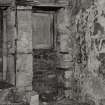Pricing Change
New pricing for orders of material from this site will come into place shortly. Charges for supply of digital images, digitisation on demand, prints and licensing will be altered.
Dundee, 9 Guthrie Street, East Mill
Flax Mill (18th Century), Steam Engine (18th Century), Steam Engine House (18th Century), Tannery (18th Century)
Site Name Dundee, 9 Guthrie Street, East Mill
Classification Flax Mill (18th Century), Steam Engine (18th Century), Steam Engine House (18th Century), Tannery (18th Century)
Alternative Name(s) Blinshall Street
Canmore ID 31975
Site Number NO33SE 68
NGR NO 39663 30316
Datum OSGB36 - NGR
Permalink http://canmore.org.uk/site/31975
- Council Dundee, City Of
- Parish Dundee (Dundee, City Of)
- Former Region Tayside
- Former District City Of Dundee
- Former County Angus
NO33SE 68 39663 30316
Flax Mill, Guthrie Street and was built for cotton about 1792 (originally a tannery) and converted to flax in 1799. Watson points out that sketches of it in the Boulton and Watt archive in Birmingham show a small, two-storey mill with adjoining engine house and domestic looking chimney. The burn which ran under the mill (the Scouringham) which suggests to Watson that there was the early use of a waterwheel that became inadequate for the job. The Guthrie Street Mill ceased spinning in in 1884 and still stands.
(page 208) East Mill, Guthrie Street
G Wilkie; J Gibson; J ands W Brown; Brown and Miller; O G Miller; Carmichael.
The first succesful Dundee Flax Mill and 'one of the olderst steam driven mills in the world'. Of great archaeological valude due to the survival of the writings of its manager, William Brown, in the early-19th century.
1793: Shown as a tannery on maps of Dundee
1799 converted to flax mill, 3 storey, ten bay. Preparing floor below ground level, with 'a central row of Y-shaped columns for horizontal drive shaft, and square holes in the ceiling for vertical shafts to first, spinning, floor' , although altered.
The second floor (reeling) survives with no columns. There is a 'Jakes' or earth closet 17 inches by 23 inches at the NW corner which was installed in 1819. There are surviving 18-inch gauge rails 'in floor [which] run towards traps'. A Boulton and Watt engine was installed in 1799 and was supplied with an iron beam ten years later. It is noted that the casing for the 18 [imperial] feet long beam is still in situ. In 1846-51 a preparing shed was added to the north of the site with the mill wall 'carried on thick iron columns'. The one storey boiler house (evidence in wall) was replaced a second 10 bay and three storey block to the East (wooden floors and iron and wooden columns). Watson notes that the ground floor is altered although the floors above appear to be intact. Watson also notes that a two storey warehouse was built at the same time (1846-51) with hoists. The North Mill (1820s-1830s period ) was much smaller: only a fragment of wall survives in Blinshall Street where it was situated.
Watson 1990; Hume 1980.
Part of 1792 Tannery, converted in 1799 to flax spinning and extended to E in 1820s-30s, completed by 1851.Fire barrier divides 3-storey mill into 2 10-bay sections, rubble built with some later harling. 3-storey, ground and 1st floor harled, ground floor windows altered but 1st and 2nd floors retain original window pattern, with larger 1st floor window at W to light engine house. E gable, 3-storey 3-bay with 2 1st floor sash and case windows and 2nd floor fixed windows flanking central hoist doors under iron hooks. Skewputts and flat-topped finial. N elevation similar, but with 1st floor of W section altered. Slate roof with 2 fire barrier walls and brick wallhead stack. Interior: ground floor altered, 1st and 2nd floors have flanged iron columns and wooden beams.
The first successful steam powered flax mill in Scotland owned by George Wilkie and then J and W Brown. William Brown was an innovative manager and has left a detailed account of his problems with East Mill. O G Miller, son-in-law and successor to William Brown, went bankrupt in 1884 and East Mill was acquired by J and C Carmichael's Ward Foundry for use as a pattern store. (Historic Environment Scotland List Entry)
Publication Account (2013)
East Mill, Guthrie Street, was built as a tannery in 1792, and was
converted to flax spinning in 1799, engined by Boulton and Watt. Owned by J & W Brown from 1809 (J R Hume, Early Days in a Dundee Mill, 1980), it is the oldest steam-powered mill in Scotland, with Y-columns to carry the driving shaft.
M Watson, 2013









![Comparata sketch drawing of columns in early flax mills [by Mark Watson, 1992], A: Ditherington (Shrewsbury), 1797; B: Warehouse of 1805 [Ditherington]; C: Hackling wing, 1811 [Ditherington); D: Grandholm Works, Aberdeen, column and saddle, 1793-94, beams post-1821; E: East Mill, Dundee, 1799; F: Broadford Works, Aberdeen , 1808; G: Campions Mill, Whitby, 1814; H: Abbotsford Mills, Kirkcaldy, pre-1822; I: North Mill, Kirkcaldy, c.1809; J: Chapel Works, Montrose, 1828.](http://i.rcahms.gov.uk/canmore/l/DP00245795.jpg)









![Comparata sketch drawing of columns in early flax mills [by Mark Watson, 1992], A: Ditherington (Shrewsbury), 1797; B: Warehouse of 1805 [Ditherington]; C: Hackling wing, 1811 [Ditherington); D: Grandholm Works, Aberdeen, column and saddle, 1793-94, beams post-1821; E: East Mill, Dundee, 1799; F: Broadford Works, Aberdeen , 1808; G: Campions Mill, Whitby, 1814; H: Abbotsford Mills, Kirkcaldy, pre-1822; I: North Mill, Kirkcaldy, c.1809; J: Chapel Works, Montrose, 1828.](http://i.rcahms.gov.uk/canmore/s/DP00245795.jpg)






